Shipley Park - Miller-Mundy
Memories
w/e 03 June 2007
All
this week's pictures were taken with a Kodak DX6490

Part 6 - The Rise and Fall of
Shipley Hall
We left Part 5 of this series near Nottingham Lodge where I said
that it was a good place to stop and reflect on our journey so
far. Before we move on, I think this is a good point to look
at the maps below. The first one below shows some points of interest
that I will refer to in this, the sixth part.
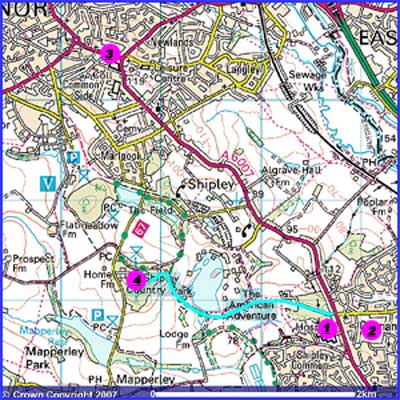
Image produced from the Ordnance Survey Get-a-map service. Image reproduced with kind permission of Ordnance Survey and Ordnance Survey of Northern Ireland.
The main entrance into the Shipley Estate estate in times gone
by was via Cotmanhay Lodge (1) and the light blue line indicates
the route to the Hall. Number (2) is the position of Cotmanhay
Church. The Market Place and St Lawrence's Church at Heanor are
indicated by (3) and the Shipley Hall site, our objective in
this part is at (4) which is where we'll also take a look at
the Miller-Mundy family tree.
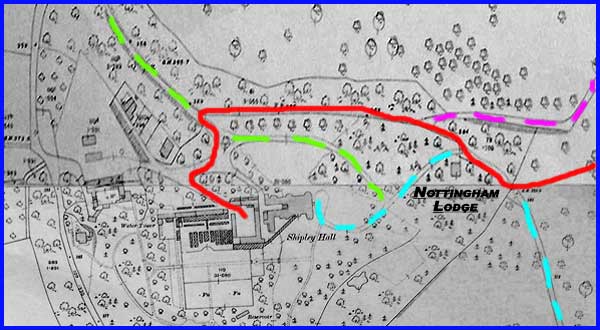
This second map shows the site layout from about a hundred years
ago. Like the first map, the light blue line indicates Coach
Road from the Cotmanhay Lodge while the green line is the alternative
route in from the Derby Lodge. The pink line is Dog Kennel Lane
that leads up the hill to Nottingham Lodge. The red line of course
shows our route into Shipley Hall along the Suffragette Wall
between the two lodges which is known as Lodge Walk. A more up
to date map is very similar although several features have now
disappeared.
|
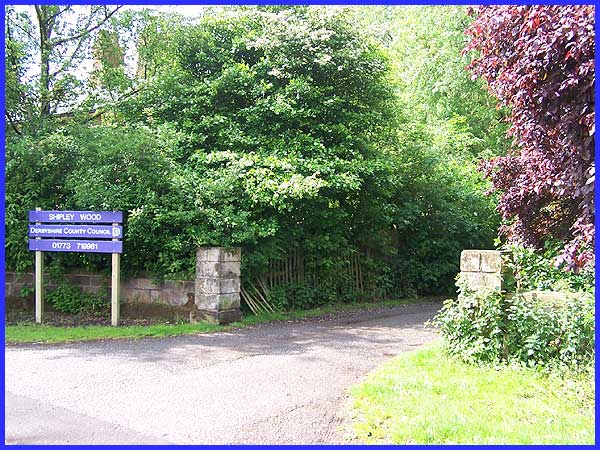
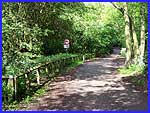 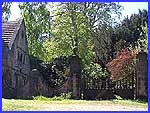 So first
of all let's take a look at the old entrance to the estate on
Heanor Road. Cotmanhay Lodge to the left of the entrance subsequently
became 311 Heanor Road. From here a lane through Shipley Wood
(left), skirted the southern end of Shipley Lake to rise up the
hill along Coach Road. At Nottingham Lodge (right) it entered
the Hall grounds and also continued to Derby Lodge which we shall
see in a later part. It's at Nottingham Lodge where we ended
in Part 5 that we'll resume our walk. So first
of all let's take a look at the old entrance to the estate on
Heanor Road. Cotmanhay Lodge to the left of the entrance subsequently
became 311 Heanor Road. From here a lane through Shipley Wood
(left), skirted the southern end of Shipley Lake to rise up the
hill along Coach Road. At Nottingham Lodge (right) it entered
the Hall grounds and also continued to Derby Lodge which we shall
see in a later part. It's at Nottingham Lodge where we ended
in Part 5 that we'll resume our walk.
|
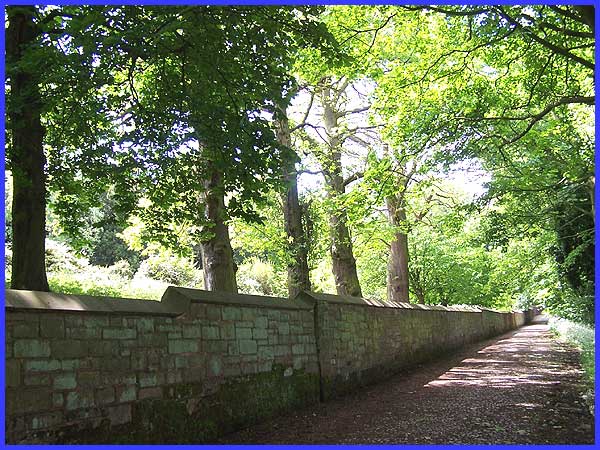
Instead of entering the grounds directly we'll continue along
Lodge Walk towards Derby Lodge by the Suffragette Wall, the original
Coach Road now being the other side of the wall. Built to protect
the estate from the suffrage movement at the beginning of the
last century I said in the previous part that it could be easily
scaled but on reflection, whilst today's young women would not
find it too much of a problem, it was probably high enough to
prove at least a deterrent to suffragettes garbed in the long
dresses that were fashionable in the Edwardian era.
|
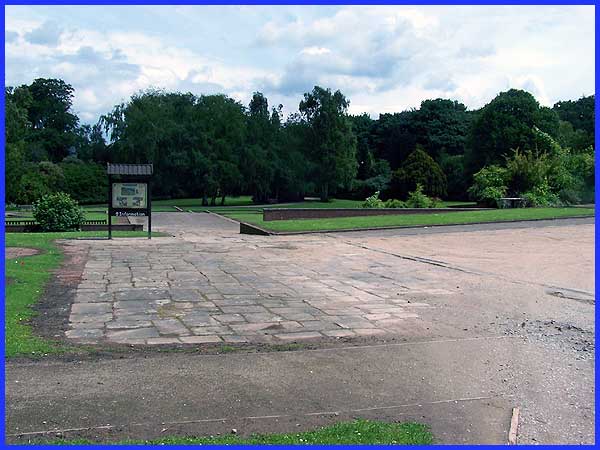
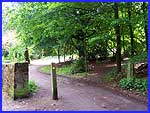 At
the end of the wall (left) we can now double back to zig-zag
through to the courtyard at the rear of Shipley Hall via the
"tradesman's entrance". This is what it looks like
today (above) and its main use now is as a car park for the vehicles
of disabled drivers who are visiting the Country Park. It was
at this point near the double sided information board that we
paused last autumn for the guide who was leading the walk in
the "Autumn Footprints" programme to summarise the
Miller-Mundy family history. That history can be traced back
to Sir Edward Leche who was Lord of the Manors of Shipley and
Duffield until his death in 1649. At
the end of the wall (left) we can now double back to zig-zag
through to the courtyard at the rear of Shipley Hall via the
"tradesman's entrance". This is what it looks like
today (above) and its main use now is as a car park for the vehicles
of disabled drivers who are visiting the Country Park. It was
at this point near the double sided information board that we
paused last autumn for the guide who was leading the walk in
the "Autumn Footprints" programme to summarise the
Miller-Mundy family history. That history can be traced back
to Sir Edward Leche who was Lord of the Manors of Shipley and
Duffield until his death in 1649.
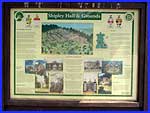 The information
board is packed with snippets about the history of the estate
and contains family crests, a floor plan of the Hall and photographs
of both the Hall and the grounds. It also includes a picture
similar to the one at the head of this page showing the Hall
in all its glory. Many visitors to the site today will be unaware
of its history but, standing quietly for a while, the past, with
the family's connections to nobility and royalty, simply oozes
out of the remains of the Hall. And if you're here at twilight
you may even hear an organ playing or see the Squire riding by
on a phantom horse. These are just two of the ghost stories told
about the family. The information
board is packed with snippets about the history of the estate
and contains family crests, a floor plan of the Hall and photographs
of both the Hall and the grounds. It also includes a picture
similar to the one at the head of this page showing the Hall
in all its glory. Many visitors to the site today will be unaware
of its history but, standing quietly for a while, the past, with
the family's connections to nobility and royalty, simply oozes
out of the remains of the Hall. And if you're here at twilight
you may even hear an organ playing or see the Squire riding by
on a phantom horse. These are just two of the ghost stories told
about the family.
|
But putting stories of apparitions to one side, prior
to to Sir Edward Leche, the Lords of Shipley Hall can be traced
back to the year 1000AD when it was held under Danelaw by Ulf
Fensic, a Viking. It eventually passed into Norman hands and
via the de Muskhams and le Vavasours to the Strelley family in
1302. The Strelleys held the estate for over 400 years but were
forced to sell it to pay off family debts in 1608 when it was
bought by Sir George Peckham (or Parkham) of Stanley Grange.
The first reference to a Hall on the site is around 1600 but
this was demolished to be replaced by a new one in 1750. This
was followed by 150 years of regular alterations, renovations
and additions but today all that remains is an outline of the
ground floor rooms.
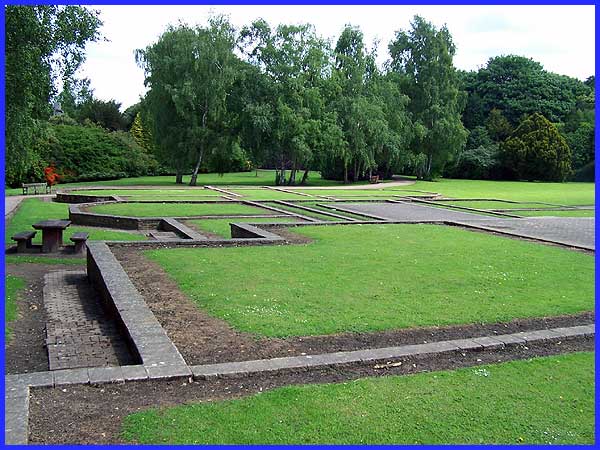
Sir George only held the estate relatively briefly selling it
to the aforementioned Sir Edward Leche of Wrotham, Maidstone,
Kent in 1626. It was Sir Edward's grandson John who married Elizabeth
Duke in 1689 and their daughter Hester married a Miller (also
of Wrotham in Kent) in 1712. They too had a daughter, also called
Hester, but she was orphaned at the age of five and was cared
for by grandmother Elizabeth. When Hester (the younger) married
into another well-to-do family from Allestree, Derby her husband
was the third son of Robert Mundy. His name was Edward Mundy
who was to become the High Sheriff of Derbyshire in 1731 but
Hester kept her surname due to the wealth she brought with her
and hence started the Miller-Mundy line. Both Hester and Edward
died in 1767 and control of the estate passed to their daughter
Hester Margaretta Miller-Mundy until her marriage to Sir Roger
Newdigate. She then had to relinquish control to her younger
brother Edward Miller-Mundy who inherited on her marriage. It
was this Edward (the 1st) who was responsible for the construction
of the Nutbrook Canal and the reservoirs at Mapperley and Shipley.

It was also during Edward's (the 1st) time that coal started
to be extracted. Edward, who became a Member of Parliament for
South Derbyshire, married three times, his second wife being
Georgiana, widow of Thomas the 4th Lord Middleton of Wollaton
Hall and his third Catherine, widow of Richard Barwell. But it
was his eldest son Edward (the 2nd) by his first marriage to
Francis Meynell, co-heiress of Godfey of Yeldersley who inherited
on his death in 1822. Edward (the 2nd) only held the estate for
twelve years as he died in 1834 when it passed to his son, another
Edward (the 3rd) who like his grandfather before him became an
MP for South Derbyshire. This Edward did not enjoy good health
and died in Barbados in 1849.
|
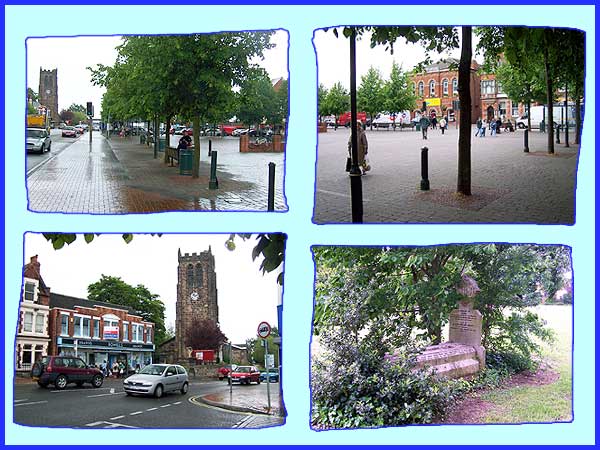
His younger brother Alfred was also living abroad - he was the
Colonial Secretary of South Australia - and, as the only remaining
child of Edward (the 2nd), returned home to inherit the Hall.
He is remembered for donating the land for Heanor Market Place
(above top), his brother Edward (the 3rd) being buried nearby
at St Lawrence's Church (above in both pictures on the left).
Alfred owned the estate for 28 years and died at Nice in 1877
but his body like his brother's, was also returned to Derbyshire
to be buried in the churchyard at Cotmanhay (above bottom right)
close to the main entrance to the estate that was mentioned earlier.
There then followed 43 years where the ownership of Shipley Hall
belonged to Alfred's son Alfred Edward who was known locally
and affectionately as "The Squire". On his death aged
71 in 1920, the estate passed to his son Godfrey.
|
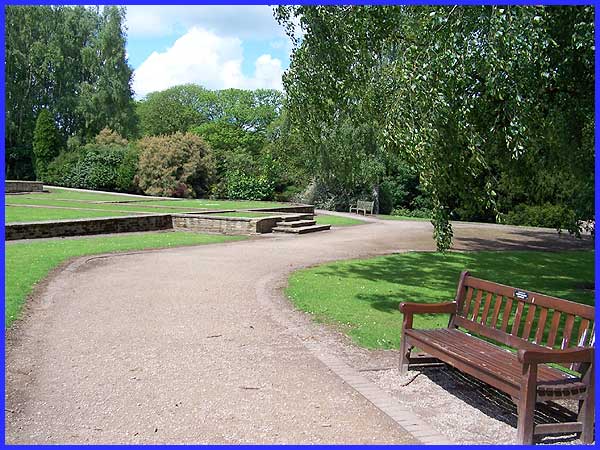
In 1922 Godfrey sold the estate to the Shipley Colliery Company
and moved to Red Rice House in Andover, Hampshire, thus bringing
to an end about 200 years of Miller-Mundy ownership. The Squire
who had been buried on Shipley Hill was moved with the family
but it was the sale of the estate that sounded the death knell
of the Hall. Whilst the Miller-Mundys had owned the estate, none
of the mining activities were allowed to encroach under the Hall
but the Shipley Colliery Company were bound by no such constraints
. Sadly what had contributed to the wealth of the Miller-Mundy
family also led to the downfall, 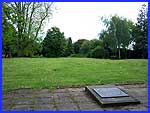 almost literally, of the Hall. After
the sale, the Hall was occupied for a time by the colliery manager
but as it says on the information board, "mining of the
rich coal reserves under the hill led to chronic subsidence and
seriously affected the foundations. It was finally demolished
in 1943 because of fears for public safety." The sale of
the estate may not have caused Alfred to turn in his grave at
Cotmanhay Church but his bones may well have been heard to rattle
in his tomb when the subsidence that resulted in the demolition
of his former home also caused the same fate befalling Cotmanhay
Church {right). Serious structural damage caused by the subsidence
meant demolition in 1983. almost literally, of the Hall. After
the sale, the Hall was occupied for a time by the colliery manager
but as it says on the information board, "mining of the
rich coal reserves under the hill led to chronic subsidence and
seriously affected the foundations. It was finally demolished
in 1943 because of fears for public safety." The sale of
the estate may not have caused Alfred to turn in his grave at
Cotmanhay Church but his bones may well have been heard to rattle
in his tomb when the subsidence that resulted in the demolition
of his former home also caused the same fate befalling Cotmanhay
Church {right). Serious structural damage caused by the subsidence
meant demolition in 1983.
If you have enjoyed this look at the history of the Shipley Estate,
be sure to visit the pages linked below to the Heanor and District
Local History Society. The Shipley page is about the Miller-Mundy
family and a gallery of old postcards shows views of the Hall
and the grounds (including pictures of Cotmanhay Lodge).
Links to Heanor and District Local History site - Shipley and Shipley Postcards
Back to Part 5 - Up Shipley Hill
------ Forward to Part 7 - Relaxation.
Use the Quick Links below to access other pages.
|